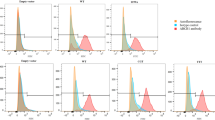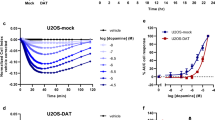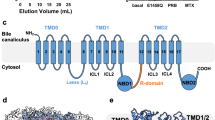Abstract
The drug efflux pump P-glycoprotein possesses two common and often linked polymorphisms that result in variable drug action. G2677T results in A893S, whereas C3435T is synonymous and has been reported to alter protein folding. We tested the effect of these MDR1 variants on Human Ether-Related A Go-Go (HERG) block by ibutilide in CHO cells 48 h following transient transfection with an IRES-dsRed vector containing MDR1, G2677T MDR1, G2677T/C3435T MDR1 or an empty bicistronic site and an IRES-GFP vector containing HERG (KCNH2). Cotransfection of MDR1 variants had no effect on IKr amplitude at baseline. Cells cotransfected with MDR1-G2677T showed resistance to ibutilide vs HERG alone (IC50: 105.3±1.42 nM vs 27.4±2.5 nM; P<0.0001), consistent with the idea that A893S attenuates IKr block by enhancing drug efflux and thus reducing the drug available to interact with the channel binding site. However, G2677T/C3435T cells showed ibutilide sensitivity similar to cells expressing HERG alone (IC50: 22.2±0.9 nM). Immunostaining showed that the C3435T variant did not traffic to the cell surface. Coculture with fexofenadine(1 μM), an MDR1 substrate known to rescue misfolding in other membrane proteins, restored cell surface expression of MDR1 G2677T/C3435T and restored resistance to block HERG by ibutilide 200 nM (98.5±0.98% vs 42.3±2.2%, P<0.001). The non-synonymous MDR1 variant G2677 T (A893S) confers resistance to ibutilide block of IKr, which is mitigated by the C3435T polymorphism through reduced protein expression, an effect that can be restored by coculture with fexofenadine. These data identify ibutilide as an MDR1 substrate and further support the concept that variable drug transport function can modulate the action of HERG blockers.
This is a preview of subscription content, access via your institution
Access options
Subscribe to this journal
Receive 6 print issues and online access
$259.00 per year
only $43.17 per issue
Buy this article
- Purchase on Springer Link
- Instant access to full article PDF
Prices may be subject to local taxes which are calculated during checkout





Similar content being viewed by others
References
Roden DM . Drug-induced prolongation of the QT interval. N Engl J Med 2004; 350: 1013–1022.
Roden DM . Genetic polymorphisms, drugs, and proarrhythmia. J Intervent Cardiac Electrophysiol 2003; 9: 131–135.
Priori SG, Schwartz PJ, Napolitano C, Bloise R, Ronchetti E, Grillo M et al. Risk stratification in the long-QT syndrome. N Engl J Med 2003; 348: 1866–1874.
Haverkamp W, Breithardt G, Camm AJ, Janse MJ, Rosen MR, Antzelevitch C et al. The potential for QT prolongation and proarrhythmia by non-antiarrhythmic drugs: clinical and regulatory implications. Report on a Policy Conference of the European Society of Cardiology. Eur Heart J 2000; 21: 1216–1231.
Mitcheson JS, Chen J, Lin M, Culberson C, Sanguinetti MC . A structural basis for drug-induced long QT syndrome. PNAS 2000; 97: 12329–12333.
Yeola SW, Rich TC, Uebele VN, Tamkun MM, Snyders DJ . Molecular analysis of a binding site for quinidine in a human cardiac delayed rectifier K+ channel : role of S6 in antiarrhythmic drug binding. Circ Res 1996; 78: 1105–1114.
Yang P, Kanki H, Drolet B, Yang T, Wei J, Viswanathan PC et al. Allelic variants in long-QT disease genes in patients with drug-associated torsades de pointes. Circulation 2002; 105: 1943–1948.
Napolitano C, Schwartz PJ, Brown AM, Ronchetti E, Bianchi L, Pinnavaia A et al. Evidence for a cardiac ion channel mutation underlying drug-induced QT prolongation and life-threatening arrhythmias. J Cardiovasc Electrophysiol 2000; 11: 691–696.
Lasser KE, Allen PD, Woolhandler SJ, Himmelstein DU, Wolfe SM, Bor DH . Timing of new black box warnings and withdrawals for prescription medications. JAMA 2002; 287: 2215–2220.
Makkar RR, Fromm BS, Steinman RT, Meissner MD, Lehmann MH . Female gender as a risk factor for torsades de pointes associated with cardiovascular drugs. JAMA 1993; 270: 2590–2597.
Houltz B, Darpo B, Edvardsson N, Blomstrom P, Brachmann J, Crijns HJ et al. Electrocardiographic and clinical predictors of torsades de pointes induced by almolanat infusion in patients with chronic atrial fibrillation or flutter: a prospective study. PACE 1998; 21: 1044–1057.
Gbadebo TD, Trimble RW, Khoo MSC, Temple J, Roden DM, Anderson ME . Calmodulin inhibitor W-7 unmasks a novel electrocardiographic parameter that predicts initiation of torsade de pointes. Circulation 2002; 105: 770–774.
Shimizu W, Antzelevitch C . Differential effects of beta-adrenergic agonists and antagonists in LQT1, LQT2 and LQT3 models of the long QT syndrome. J Amer College Cardiol 2000; 35: 778–786.
Zhou M, Morais-Cabral JH, Mann S, MacKinnon R . Potassium channel receptor site for the inactivation gate and quaternary amine inhibitors. Nature 2001; 411: 657–661.
Jazwinska-Tarnawska E, Orzechowska-Juzwenko K, Niewinski P, Rzemislawska Z, Loboz-Grudzien K, Dmochowska-Perz M et al. The influence of CYP2D6 polymorphism on the antiarrhythmic efficacy of propafenone in patients with paroxysmal atrial fibrillation during 3 months propafenone prophylactic treatment. Int J Clin Pharmacol Ther 2001; 39: 288–292.
Woodahl EL, Yang Z, Bui T, Shen DD, Ho RJY . Multidrug resistance gene G1199A polymorphism alters efflux transport activity of P-glycoprotein. J Pharmacol Exp Ther 2004; 310: 1199–1207.
Schinkel AH, Wagenaar E, Mol CAAM, van Deemter L . P-glycoprotein in the blood–brain barrier of mice influences the brain penetration and pharmacological activity of many drugs. J Clin Invest 1996; 97: 2517–2524.
Marzolini C, Kim RB . Placental transfer of antiretroviral drugs. Clin Pharmacol Ther 2005; 78: 118–122.
Chan LMS, Lowes S, Hirst BH . The ABCs of drug transport in intestine and liver: efflux proteins limiting drug absorption and bioavailability. Eur J Pharm Sci 2004; 21: 25–51.
Niemi M, Backman JT, Kajosaari LI, Leathart JB, Neuvonen M, Daly AK et al. Polymorphic organic anion transporting polypeptide 1B1 is a major determinant of repaglinide pharmacokinetics. Clin Pharmacol Ther 2005; 77: 468–478.
Potschka H, Loscher W . Blood–brain barrier active efflux transporters: ATP-binding cassette gene family. NeuroRx 2005; 2: 86–98.
Kusuhara H, Sugiyama Y . Active efflux across the blood brain barrier: role of the solute carrier family. NeuroRx 22005; 2: 73–85.
Ho RH, Kim RB . Transporters and drug therapy: implications for drug disposition and disease. Clin Pharmacol Ther 2005; 78: 260–277.
Grube M, Meyer zu Schwabedissen HEU, Prager D, Haney J, Moritz KU, Meissner K et al. Uptake of cardiovascular drugs into the human heart: expression, regulation, and function of the carnitine transporter OCTN2 (SLC22A5). Circulation 2006; 113: 1114–1122.
Kim RB, Leake BF, Choo EF, Dresser GK, Kubba SV, Schwarz UI et al. Identification of functionally variant MDR1 alleles among European Americans and African Americans. Clin Pharmacol Ther 2001; 70: 189–199.
Kurata Y, Ieiri I, Kimura M, Morita T, Irie S, Urae A et al. Role of human MDR1 gene polymorphism in bioavailability and interaction of digoxin, a substrate of P-glycoprotein. Clin Pharmacol Ther 2002; 72: 209–219.
Kim KA, Park PW, Park JY . Effect of ABCB1 (MDR1) haplotypes derived from G2677T/C3435T on the pharmacokinetics of amlodipine in healthy subjects. Brit J Clin Pharmacol 2007; 63: 53–58.
Illmer T, Schuler US, Thiede C, Schwarz UI, Kim RB, Gotthard S et al. MDR1 gene polymorphisms affect therapy outcome in acute myeloid leukemia patients. Cancer Res 2002; 62: 4955–4962.
Yamauchi A, Ieiri I, Kataoka Y, Tanabe M, Nishizaki T, Oishi R et al. Neurotoxicity induced by tacrolimus after liver transplantation: relation to genetic polymorphisms of the ABCB1 (MDR1) gene. Transplantation 2002; 74: 571–572. 8-27-2002.
Elens L, Capron A, Kerckhove VV, Lerut J, Mourad M, Lison D et al. 1199G>A and 2677G>T/A polymorphisms of ABCB1 independently affect tacrolimus concentration in hepatic tissue after liver transplantation. Pharmacogenet Pharmacogenomics 2007; 17: 873–883. 10-17-2007.
Kimchi-Sarfaty C, Oh JM, Kim IW, Sauna ZE, Calcagno AM, Ambudkar SV et al. A ‘silent’ polymorphism in the MDR1 gene changes substrate specificity. Science 2007; 315: 525–528.
Rajamani S, Anderson CL, Anson BD, January CT . Pharmacological rescue of human K+ channel long-QT2 mutations. Circulation 2002; 105: 2830–2835.
Bozina N, Kuzman MR, Medved V, Jovanovic N, Sertic J, Hotujac L . Associations between MDR1 gene polymorphisms and schizophrenia and therapeutic response to olanzapine in female schizophrenic patients. J Psychiatr Res 2008; 42: 89–97.
Aarnoudse ALHJ, van Schaik RHN, Dieleman J, Molokhia M, van Riemsdijk MM, Ligthelm RJ et al. MDR1 gene polymorphisms are associated with neuropsychiatric adverse effects of mefloquine. Clin Pharmacol Ther 2006; 80: 367–374.
Sohn JW, Lee SY, Lee SJ, Kim EJ, Cha SI, Kim CH et al. MDR1 polymorphisms predict the response to etoposide–cisplatin combination chemotherapy in small cell lung cancer. Jpn J Clin Oncol 2006; 36: 137–141.
Kim DH, Park JY, Sohn SK, Lee NY, Baek JH, Jeon SB et al. Multidrug resistance-1 gene polymorphisms associated with treatment outcomes in de novo acute myeloid leukemia. Int J Cancer 2006; 118: 2195–2201.
Seo T, Ishitsu T, Ueda N, Nakada N, Yurube K, Ueda K et al. ABCB1 polymorphisms influence the response to antiepileptic drugs in Japanese epilepsy patients. Pharmacogenomics 2006; 7: 551–561.
Clinckers R, Smolders I, Meurs A, Ebinger G, Michotte Y . Quantitative in vivo microdialysis study on the influence of multidrug transporters on the blood–brain barrier passage of oxcarbazepine: concomitant use of hippocampal monoamines as pharmacodynamic markers for the anticonvulsant activity. J Pharmacol Exp Ther 2005; 314: 725–731.
Tishler D, Weingberg K, Hinton D, Barbaro N, Annett G, Raffel C . MDR1 gene expression in brain of patients with medically intractable epilepsy. Epilepsia 1995; 36: 1–6.
Cha TJ, Ehrlich JR, Zhang L, Shi YF, Tardif JC, Leung TK et al. Dissociation between ionic remodeling and ability to sustain atrial fibrillation during recovery from experimental congestive heart failure. Circulation 2004; 109: 412–418.
Li D, Melnyk P, Feng J, Wang Z, Petrecca K, Shrier A et al. Effects of experimental heart failure on atrial cellular and ionic electrophysiology. Circulation 2000; 101: 2631–2638.
Schoonderwoerd BA, Van Gelder IC, Van Veldhuisen DJ, Van den Berg MP, Crijns HJGM . Electrical and structural remodeling: role in the genesis and maintenance of atrial fibrillation. Progress Cardiovasc Dis 2005; 48: 153–168.
Hamill OP, Marty A, Neher E, Sakmann B, Sigworth FJ . Improved patch-clamp techniques for high-resolution current recording from cells and cell-free membrane patches. Pflugers Archive: Eur J Physiol 1981; 391: 85–100. 8-1-1981.
Yang T, Snyders D, Roden DM . Drug block of IKr: model systems and relevance to human arrhythmias. J Cardiovasc Pharmacol 2001; 38: 737–744.
Acknowledgements
This work was supported by grants (GM07569; HL65962) from the National Heart Lung and Blood Institute.
Author information
Authors and Affiliations
Corresponding author
Additional information
Duality of interest
None declared.
Rights and permissions
About this article
Cite this article
McBride, B., Yang, T. & Roden, D. Influence of the G2677T/C3435T haplotype of MDR1 on P-glycoprotein trafficking and ibutilide-induced block of HERG. Pharmacogenomics J 9, 194–201 (2009). https://doi.org/10.1038/tpj.2009.1
Received:
Revised:
Accepted:
Published:
Issue Date:
DOI: https://doi.org/10.1038/tpj.2009.1
Keywords
This article is cited by
-
Intracellular Binding of Terfenadine Competes with Its Access to Pancreatic ß-cell ATP-Sensitive K+ Channels and Human ether-à-go-go-Related Gene Channels
The Journal of Membrane Biology (2023)
-
Domperidone Treatment for Gastroparesis: Demographic and Pharmacogenetic Characterization of Clinical Efficacy and Side-Effects
Digestive Diseases and Sciences (2011)



